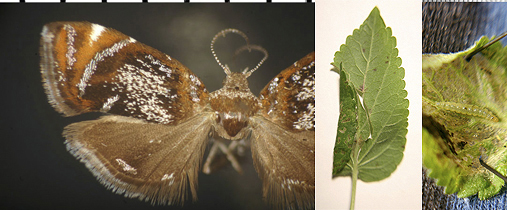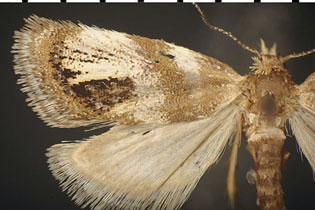
Prochoreutis inflatella (Fig. 1) skeletonizes leaves of woodland skullcaps, Scutellaria spp. (Lamiaceae). There are several generations per year, with the first larvae appearing in March, only shortly after the host plant begins growth. Pupation occurs in a fusiform, multi-layered cocoon of white silk, as is typical for the leaf-feeding species of Choreutidae in Illinois.

Figure 1. Prochoreutis inflatella. Adult; leaf of skullcap, Scutellaria sp. (Lamiaceae), showing larval feeding damage; and mature larva.
Prochoreutis extrincicella (Fig. 2) has been collected in the adult stage in Hancock and Jersey counties in Illinois. Evidently, the life history is unknown. Collection dates of adults indicate one generation in Illinois, with adults in early to mid-May. The larval foodplant is unknown, but if P. extrincicella follows the typical generic pattern of feeding on plants in the mint family (Lamiaceae), then Teucrium canadense is a candidate for being its larval host plant, as the Jersey County individual was collected near a large stand of that plant, which was the only mint observed in the area.

Figure 2. Prochoreutis extrincicella. Adult (collected at light).